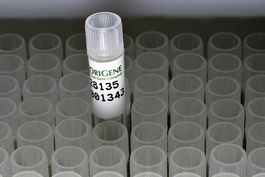CREB3 (NM_006368) Human Tagged ORF Clone
CAT#: RC203489L4
- LentiORF®
Lenti ORF clone of Human cAMP responsive element binding protein 3 (CREB3), mGFP tagged
"NM_006368" in other vectors (6)
Product Images

Specifications
| Product Data | |
| Type | Human Tagged ORF Clone |
| Tag | mGFP |
| Symbol | CREB3 |
| Synonyms | LUMAN; LZIP; sLZIP |
| Vector | pLenti-C-mGFP-P2A-Puro |
| E. coli Selection | Chloramphenicol (34 ug/mL) |
| Mammalian Cell Selection | Puromycin |
| Sequence Data |
The ORF insert of this clone is exactly the same as(RC203489).
|
| Restriction Sites | SgfI-MluI Cloning Scheme for this gene |
| ACCN | NM_006368 |
| ORF Size | 1113 bp |
| OTI Disclaimer | The molecular sequence of this clone aligns with the gene accession number as a point of reference only. However, individual transcript sequences of the same gene can differ through naturally occurring variations (e.g. polymorphisms), each with its own valid existence. This clone is substantially in agreement with the reference, but a complete review of all prevailing variants is recommended prior to use. More info |
| OTI Annotation | This clone was engineered to express the complete ORF with an expression tag. Expression varies depending on the nature of the gene. |
| Reference Data | |
| RefSeq | NM_006368.4, NP_006359.3 |
| RefSeq Size | 1868 |
| RefSeq ORF | 1116 |
| Locus ID | 10488 |
| Domains | BRLZ |
| Protein Families | Transcription Factors |
| Protein Pathways | Huntington's disease, Melanogenesis, Prostate cancer |
| MW | 41.4 kDa |
| Gene Summary | This gene encodes a transcription factor that is a member of the leucine zipper family of DNA binding proteins. This protein binds to the cAMP-response element and regulates cell proliferation. The protein interacts with host cell factor C1, which also associates with the herpes simplex virus (HSV) protein VP16 that induces transcription of HSV immediate-early genes. This protein and VP16 both bind to the same site on host cell factor C1. It is thought that the interaction between this protein and host cell factor C1 plays a role in the establishment of latency during HSV infection. This protein also plays a role in leukocyte migration, tumor suppression, and endoplasmic reticulum stress-associated protein degradation. Additional transcript variants have been identified, but their biological validity has not been determined. [provided by RefSeq, Nov 2009] |
Documents
| Product Manuals |
| FAQs |
| SDS |
Resources
Other Versions
| SKU | Description | Size | Price |
|---|---|---|---|
| SC319314 | CREB3 (untagged)-Human cAMP responsive element binding protein 3 (CREB3) |
USD 310.00 |
|
| RC203489 | CREB3 (Myc-DDK-tagged)-Human cAMP responsive element binding protein 3 (CREB3) |
USD 420.00 |
|
| RG203489 | CREB3 (GFP-tagged) - Human cAMP responsive element binding protein 3 (CREB3) |
USD 460.00 |
|
| RC203489L1 | Lenti ORF clone of Human cAMP responsive element binding protein 3 (CREB3), Myc-DDK-tagged |
USD 620.00 |
|
| RC203489L2 | Lenti ORF clone of Human cAMP responsive element binding protein 3 (CREB3), mGFP tagged |
USD 620.00 |
|
| RC203489L3 | Lenti ORF clone of Human cAMP responsive element binding protein 3 (CREB3), Myc-DDK-tagged |
USD 620.00 |
{0} Product Review(s)
Be the first one to submit a review






























































































































































































































































 Germany
Germany
 Japan
Japan
 United Kingdom
United Kingdom
 China
China
